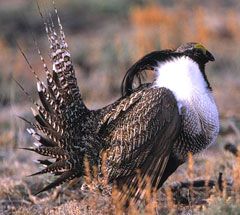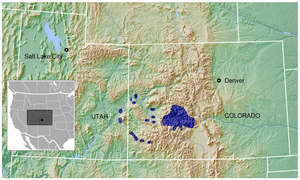Gunnison grouse facts for kids
Quick facts for kids Gunnison sage-grouse |
|
|---|---|
 |
|
| Conservation status | |
| Scientific classification | |
| Genus: |
Centrocercus
|
| Species: |
minimus
|
 |
|
| Gunnison sage-grouse range | |
The Gunnison sage-grouse (Centrocercus minimus) is a special type of grouse, which is a bird that lives on the ground. This bird is found only in a specific area of the Great Basin in the western United States. It looks a lot like its close relative, the greater sage-grouse, but it's about one-third smaller.
One way to tell the Gunnison sage-grouse apart is by the thick feathers, called plumes, behind its head. It also has a simpler courtship dance compared to the greater sage-grouse. These birds mostly live in the western part of Colorado and eastern Utah, especially in the Gunnison Basin region of Colorado.
Contents
About the Gunnison Sage-Grouse
The Gunnison sage-grouse is a unique bird that was first officially recognized as its own species in the year 2000. Before that, scientists thought it was just a smaller version of the greater sage-grouse. However, after careful study of its genes, size, and behavior, they realized it was different enough to be its own species.
What Does It Look Like?
The Gunnison sage-grouse is a medium-sized bird. Adult males are larger than females. They have a plump body, a short tail, and feathered legs. Their feathers are a mix of brown, black, and white, which helps them blend in with the sagebrush plants where they live. This camouflage keeps them safe from predators.
Both males and females have a black belly and a white chest. Males have a special feature: two yellowish-green air sacs on their chest. They inflate these sacs during their mating dance, which makes a bubbling sound. They also have long, spiky tail feathers.
Where Do They Live?
Gunnison sage-grouse live in areas with lots of sagebrush plants. These plants are very important for their survival. Sagebrush provides them with food, shelter from bad weather, and places to hide from predators. They prefer open areas with tall sagebrush, often near valleys or plains.
Their main home is in the Gunnison Basin of Colorado. Smaller groups also live in other parts of Colorado and a few spots in eastern Utah. Their habitat is often cold in winter and warm in summer, so they need the sagebrush to help them survive these changes.
What Do They Eat?
The diet of the Gunnison sage-grouse changes with the seasons. In winter, their main food source is the leaves of the sagebrush plant. This plant is one of the few green things available when snow covers the ground.
In spring and summer, they also eat a variety of other plants, like wildflowers and grasses. Young chicks mostly eat insects, such as ants and beetles, which are full of protein and help them grow quickly. As they get older, they start eating more plant material.
Life Cycle and Reproduction
The most famous part of the Gunnison sage-grouse's life is its amazing courtship display.
The Courtship Dance
Every spring, usually from March to May, male Gunnison sage-grouse gather at special open areas called "leks." A lek is like a dance floor where males perform to attract females. This is called "lekking."
During the dance, the male grouse puffs up his chest, inflates his yellow air sacs, and struts around. He fans his spiky tail feathers and makes a unique bubbling sound. He also makes a swishing noise with his wings. All of this is to show off his strength and health to the females. Females visit the lek to choose the strongest and healthiest male to mate with.
Nests and Chicks
After mating, the female sage-grouse builds a nest on the ground, usually hidden under a sagebrush plant. The nest is a simple scrape in the soil, lined with grass and feathers. She lays about 6 to 8 eggs, which are spotted to help them blend in with the ground.
The female incubates the eggs by herself for about 25 to 27 days. Once the chicks hatch, they are able to walk and find food almost immediately. The mother bird protects them and teaches them how to find food. The chicks grow very quickly, and by the end of summer, they are almost full-grown.
Conservation Efforts
The Gunnison sage-grouse is an endangered species. This means their numbers are very low, and they are at risk of disappearing forever.
Why Are They in Danger?
The biggest threat to the Gunnison sage-grouse is the loss and breaking up of their sagebrush habitat.
- Habitat Loss: As humans build more homes, roads, and farms, the sagebrush lands are shrinking.
- Habitat Fragmentation: Even if the land isn't completely destroyed, roads and buildings can break up large areas of sagebrush into smaller pieces. This makes it harder for the grouse to move around and find food or mates.
- Wildfires: Large wildfires can destroy vast areas of sagebrush, which takes a very long time to grow back.
- Invasive Plants: Some non-native plants, like cheatgrass, can outcompete sagebrush and also increase the risk of wildfires.
- Predators: With less hiding cover, they become easier targets for predators like coyotes, eagles, and ravens.
What's Being Done to Help?
Many people and organizations are working hard to protect the Gunnison sage-grouse.
- Habitat Restoration: Efforts are being made to restore damaged sagebrush habitats by planting new sagebrush and removing invasive plants.
- Land Protection: Some areas of sagebrush land are being protected from development.
- Research: Scientists are studying the grouse to learn more about their needs and how best to help them.
- Working with Landowners: Conservation groups are working with ranchers and farmers to find ways to manage land that benefits both people and the grouse.
Protecting the Gunnison sage-grouse is important because it helps keep the sagebrush ecosystem healthy for many other animals and plants too.
See also
 In Spanish: Urogallo de Gunnison para niños
In Spanish: Urogallo de Gunnison para niños


